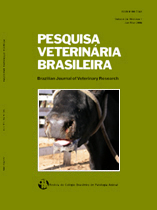 |
|
|
|
Year 2007 - Volume 27, Number 07
|

|
Fibrinonecrotic enteritis of piglets in a commercial farm: a postmortem study of the prevalence and the role of lesion associated agents Isospora suis and Clostridium perfringens, p.297-300
|
ABSTRACT.- Sanz M.G., Venturini L., Assis R.A., Uzal F., Risso M.A., Idiart J.R. & Perfumo C.J. 2007. Fibrinonecrotic enteritis of piglets in a commercial farm: a postmortem study of the prevalence and the role of lesion associated agents Isospora suis and Clostridium perfringens. Pesquisa Veterinária Brasileira 27(7):297-300. Facultad de Ciencias Veterinarias, Universidad Nacional de La Plata, CC 296, B1900 AVW, 60 y 119, La Plata, Argentina. E-mail: cjperfumo@fcv.unlp.edu.ar
The objectives were to determine the prevalence of fibrinonecrotic enteritis (FNE) on a farrow-to-finish farm of 1,000 sows, to categorize the pathological changes, and to to investigate the lesion associated agents Isospora suis and Clostridium perfringens. Causes of preweaning mortality (PWM) were classified into 8 categories including FNE. Obtained data were evaluated for statistical significance by adjusted Chi-square analysis. Samples of FNE were taken for complementary studies including a PCR technique for genotyping toxin genes of Clostridium perfringens from gut samples fixed in 10% neutral formalin. From 3,153 piglets examined, less than 1% was classified as FNE. FNE prevalence increased progressively from the first to the third week, the last differing statistically from the others. Eighty percent of gut samples with FNE lesions were positive to Isospora suis, when examined by PCR from 9 severe FNE lesions detected 7 positive samples only for a toxin gene, characteristic of C. perfringens type-A. |
| |
|
|
| |
|
 |